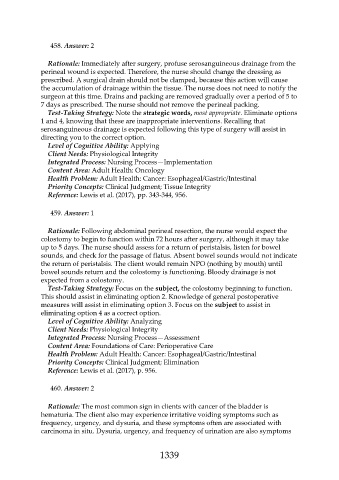Page 1339 - Saunders Comprehensive Review For NCLEX-RN
P. 1339
458. Answer: 2
Rationale: Immediately after surgery, profuse serosanguineous drainage from the
perineal wound is expected. Therefore, the nurse should change the dressing as
prescribed. A surgical drain should not be clamped, because this action will cause
the accumulation of drainage within the tissue. The nurse does not need to notify the
surgeon at this time. Drains and packing are removed gradually over a period of 5 to
7 days as prescribed. The nurse should not remove the perineal packing.
Test-Taking Strategy: Note the strategic words, most appropriate. Eliminate options
1 and 4, knowing that these are inappropriate interventions. Recalling that
serosanguineous drainage is expected following this type of surgery will assist in
directing you to the correct option.
Level of Cognitive Ability: Applying
Client Needs: Physiological Integrity
Integrated Process: Nursing Process—Implementation
Content Area: Adult Health: Oncology
Health Problem: Adult Health: Cancer: Esophageal/Gastric/Intestinal
Priority Concepts: Clinical Judgment; Tissue Integrity
Reference: Lewis et al. (2017), pp. 343-344, 956.
459. Answer: 1
Rationale: Following abdominal perineal resection, the nurse would expect the
colostomy to begin to function within 72 hours after surgery, although it may take
up to 5 days. The nurse should assess for a return of peristalsis, listen for bowel
sounds, and check for the passage of flatus. Absent bowel sounds would not indicate
the return of peristalsis. The client would remain NPO (nothing by mouth) until
bowel sounds return and the colostomy is functioning. Bloody drainage is not
expected from a colostomy.
Test-Taking Strategy: Focus on the subject, the colostomy beginning to function.
This should assist in eliminating option 2. Knowledge of general postoperative
measures will assist in eliminating option 3. Focus on the subject to assist in
eliminating option 4 as a correct option.
Level of Cognitive Ability: Analyzing
Client Needs: Physiological Integrity
Integrated Process: Nursing Process—Assessment
Content Area: Foundations of Care: Perioperative Care
Health Problem: Adult Health: Cancer: Esophageal/Gastric/Intestinal
Priority Concepts: Clinical Judgment; Elimination
Reference: Lewis et al. (2017), p. 956.
460. Answer: 2
Rationale: The most common sign in clients with cancer of the bladder is
hematuria. The client also may experience irritative voiding symptoms such as
frequency, urgency, and dysuria, and these symptoms often are associated with
carcinoma in situ. Dysuria, urgency, and frequency of urination are also symptoms
1339

